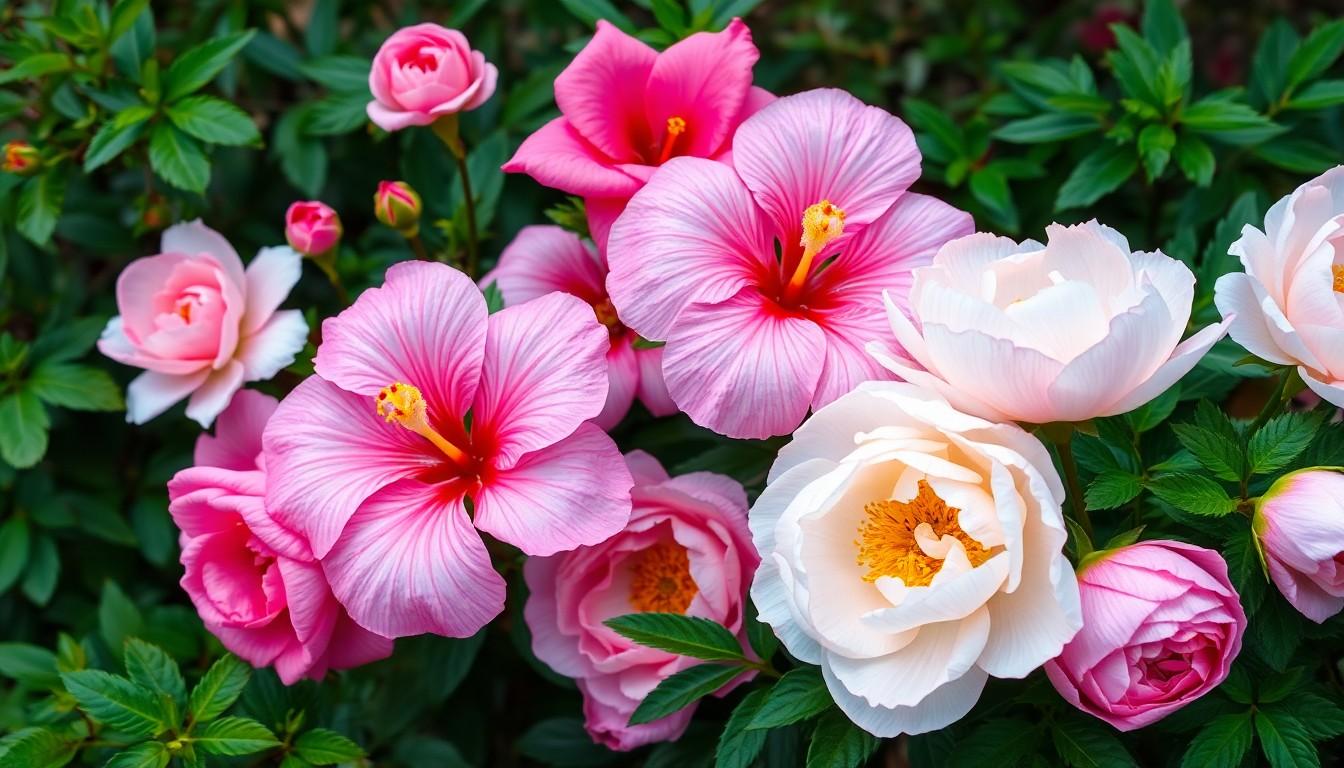In a world bursting with color, pink flowers steal the show, captivating hearts and gardens alike. But identifying these floral beauties can feel like a game of botanical charades. With so many shades and shapes, it’s easy to mix up a peony with a petunia. Fear not, plant enthusiasts! This guide is here to help you navigate the delightful maze of pink blooms.
Overview of Pink Flower Plants
Pink flower plants display an array of hues, sizes, and shapes. Various species captivate gardeners with their vibrant colors and unique features. Identifying these plants often involves recognizing specific traits, such as leaf shape, overall height, and growth patterns.
Roses, for instance, offer dense blooms and fragrant profiles. Peonies stand out with large, lush petals and bold growth. Petunias are characterized by their spreading habit and soft, velvety texture. Each species requires different growing conditions, making understanding their needs crucial for successful cultivation.
Among perennial favorites are pink coneflowers. These plants thrive in sunny areas and produce stunning daisy-like blossoms. Zinnias also gain popularity, known for their bright pink variations and ease of care. Furthermore, pink hyacinths add delightful fragrances to gardens in springtime.
When exploring pink flowers, evaluating foliage provides additional clues. The leaves of a pink magnolia differ distinctly from those of a pink lily. Observing plant structures helps in correct identification, minimizing confusion.
Common habitats for these plants range from garden beds to wild flower fields. Some are suitable for containers, while others flourish in well-drained soil. Understanding their preferred environments aids in selection for landscaping or indoor decoration.
Gardeners searching for pink flowers can reference regional guides to pinpoint species suitable for their area. Local plant nurseries often offer expert advice, enhancing successful gardening experiences. Each variety contributes beauty to any space, making identification both an enjoyable and rewarding endeavor.
Common Types of Pink Flowering Plants

Identifying pink flowering plants includes understanding key varieties. There are several popular types to consider, each with distinctive features.
Rose Varieties
Roses present an extensive range of pink shades. Hybrid tea roses, with their large blooms, provide elegance in gardens. Floribunda roses, known for their clusters of flowers, offer vibrant displays. Climbing roses, ideal for trellises, harmonize beauty and vertical growth. Shrub roses require minimal care and bloom profusely. To appreciate their fragrance, many gardeners select hybrid varieties. Understanding specific needs promotes successful cultivation of these diverse types.
Hibiscus Types
Hibiscus plants boast large, striking flowers. Hardy hibiscus species thrive in colder climates, displaying prominent petals in various pink hues. Tropical hibiscus, often grown in warmer zones, features exotic blooms and lush foliage. Both types attract butterflies and hummingbirds. Identifying them involves observing leaf shapes and growth patterns. These plants flourish in full sun and benefit from regular watering. Observing their unique characteristics aids in proper identification.
Peony Features
Peonies are celebrated for their exquisite blooms. Herbaceous peonies emerge from the ground each spring, displaying fragrant flowers that attract pollinators. Tree peonies differ with their woody stems, offering larger blossoms and earlier blooms. Intersectional peonies combine traits of both types, resulting in unique colors and forms. Leaf structure and growth habits help discern these varieties. Peonies thrive in rich, well-drained soil and prefer cooler climates for optimal growth. Understanding their needs enhances success in cultivation.
Key Characteristics for Identification
Identifying pink flower plants relies on understanding specific traits. Noteworthy characteristics include leaf shape and color, along with flower shape and size.
Leaf Shape and Color
Leaf shape varies among species, influencing identification. Broad, lobed, and pointed leaves represent distinct plants. For instance, roses typically feature serrated edges while peonies display smooth contours. Color also plays a significant role; bright green leaves might indicate healthy growth, while darker shades may suggest different species. Observing the arrangement of leaves on stems contributes further to identification. Opposite or alternate leaf arrangements can help distinguish between similar plants.
Flower Shape and Size
Flower shape and size significantly impact identification efforts. Bell-shaped petals belong to some varieties, while others boast flat or tubular forms. For example, petunias often exhibit trumpet-like blooms, contrasting with the rounded flowers of zinnias. Size varies widely as well; small, delicate buds indicate specific species, whereas large, showy blooms suggest another category altogether. Recognizing the overall structure and arrangement of petals aids in accurate identification, making it easier to group similar plants.
Tools and Techniques for Identification
Identifying pink flower plants requires the right resources and techniques. Utilizing field guides and digital tools provides effective methods for accurate identification.
Field Guides and Apps
Field guides serve as valuable resources for plant identification. These books often detail various species, including crucial features like leaf shape and flower color. Apps can enhance the identification process through visual recognition technology. Users can take photos of flowers and receive instant identification results. Notably, apps that incorporate databases of regional flora offer tailored insights. Reading user reviews helps in selecting the most effective app for specific needs.
Home Gardening Tips
Home gardening presents practical ways to identify pink flower plants. Observing distinguishing features enhances recognition skills over time. Keeping a journal of plant observations aids in tracking growth patterns and flowering times. Engaging with local gardening clubs fosters shared knowledge and assistance. Additionally, participating in workshops allows for hands-on experience with various species. Utilizing the advice from experienced gardeners serves as a resource for identifying characteristics unique to specific plants.
Conclusion
Identifying pink flower plants can be a delightful journey for any gardening enthusiast. With a keen eye for detail and an understanding of specific characteristics like leaf shape and flower size, anyone can enhance their plant identification skills. Utilizing tools such as field guides and digital apps further simplifies the process, making it accessible and enjoyable.
Engaging with local gardening communities and participating in workshops can deepen one’s appreciation for these beautiful blooms. By embracing the unique traits of each pink flower, gardeners not only cultivate their gardens but also enrich their overall gardening experience.

